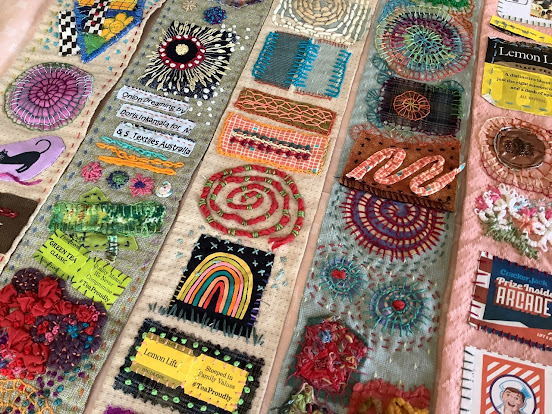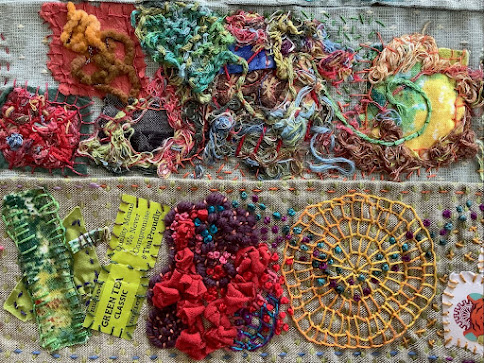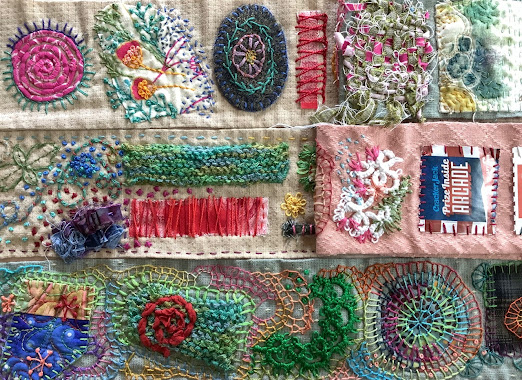The 2022 100 Day Project came to an end on May 23. For my 100 Days of Slow Stitching: Stitched Scrolls with Found Objects and Fallen Pieces, I showed up every day and have 5 hand stitched journal scrolls that show the results of this daily practice. I love them!
 |
| The 100 Day Project 2022: Stitching Found Objects and Fallen Pieces. |
100 days of Found Objects and Fallen Pieces
To get started, I gathered leftover bits (fallen pieces) from various past projects to fill two small baggies. By being observant and present during this daily exercise, I discovered a number of random, everyday items that are often taken for granted or discarded. This expanded my selection of "found objects." Both were incorporated these into my stitch journal scrolls. A few of them include...
Hotel and travel paraphernalia: key card paper envelopes, soap wrappers, and food coupons.
 |
| Hotel paraphernalia: paper key card envelopes and soap wrappers. |
Tea bag tags and wrappers: have you ever taken time to read the tags on the end of tea bag strings?
 |
| Tea bag wrappers and tags on the end of the tea bag strings. |
Postage stamps: there are colorful commemorative first class postage stamps and "themed" cancellation marks (like "Energy Awareness Month") adorning our mail pieces.
 |
| Commemorative postage stamps. |
Colorful texture was created by couching down thrums and crumbs—yarn bits, handmade paper scraps, fabric trimmings, thread waste—to the fabric scrolls.
 |
| Thrums and crumbs create colorful texture. |
New embroidery stitches and new favorites
The more one practices, the better one gets. This is true for embroidery. And I found I grew fonder of some basic stitches by doing them more frequently, and with new color combinations, and different types and weights of thread.
Couching: the laying of threads [or yarn or fabric slivers] on the surface of the fabric and securing them or anchoring them with small stitches of another thread.
 |
| Couching yarn, knit fabric slivers, quilt trimmings, etc. with various threads. |
Blanket stitch: this stitch has so many variations and possibilities. It can be uniform in size and shape or very organic. I've used multiple thread colors and used it to appliqué and couch other fabrics and threads. My favorite motif is creating a mandala/circle by working from the center outwards.
 |
| The blanket stitch and its variations. |
Three embroidery stitch books from the '60s and '70s were used as reference to learn new stitches. This 100 Day Slow Stitching Project was a good opportunity to try something new.
 |
| A stitch sampler of new-to-me stitches. |
Finding new materials for stitching
Fallen pieces included "fabric slivers" from the serger and trimmings from the rotary cutter. If you have a large eye needle, these slivers can be threaded through the needle and used to stitch—lazy daisy stitches, ruffles, spider web roses and other embroidery stitches.
 |
| Embroidering with knit and woven fabric slivers. |
Incorporating other handwork techniques
It was fun to incorporate samples of other techniques into the stitch journal: hand weaving, quilted scraps, knitting swatches, and tatting samples.
 |
| Incorporating weaving, knitting, tatting and quilted samples. |
Five stitched scrolls: front and back
Here are my 5 stitched scrolls end to end.
 |
| Five stitched scrolls from The 100 Day Project 2022. |
And no embroidery project would not be complete without showing the back.
 |
| Backs of the stitched scrolls. |
Take time to notice the small things that are often overlooked.

.jpg)








